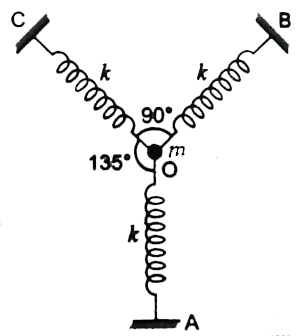An object of mass m is attached to a spring. The restroing force of the spring is F−λx3, where x is the displacement. The oscillation period depends on the mass, lmabd and oscillation amplitude. Suppose the object is initially at rest. If the initial displacement is D then its period is τ. If the initial displacement is 2D, find the period.
8τ
2τ
τ
τ/2
The correct Answer is:D
Through dimensional analysis [λ]=[ML−2T−2]
T∝maλbAc
[T]=[M]a[ML−2T−2]b[L]c
a=12,b=−12,c=−1
T=∝1A
Topper's Solved these Questions
- SIMPLE HARMONIC MOTIONBook:ALLENChapter:SIMPLE HARMONIC MOTIONExercise:Exercise-02
Explore 19 Videos
- SIMPLE HARMONIC MOTIONBook:ALLENChapter:SIMPLE HARMONIC MOTIONExercise:Exercise- 3 Match The Column
Explore 1 Video
- SIMPLE HARMONIC MOTIONBook:ALLENChapter:SIMPLE HARMONIC MOTIONExercise:Example
Explore 1 Video
- RACEBook:ALLENChapter:RACEExercise:Basic Maths (Wave Motion & Dopplers Effect) (Stationary waves & doppler effect, beats)
Explore 25 Videos
- TEST PAPERBook:ALLENChapter:TEST PAPERExercise:PHYSICS
Explore 4 Videos
Similar Questions
A particle moves such that its acceleration ‘a’ is given bya=–zxwhere x is the displacement from equilibrium position and z is constant. The period of oscillation is
View SolutionA particle moves such that its acceleration a is given by a = -bx , where x is the displacement from equilibrium positionand is a constant. The period of oscillation is
View Solution
Knowledge Check
An object of mass m, oscillating on the end of a spring with spring constant k has amplitude A. its maximum speed is
AA√k/mBA2k/mCA√m/kDAm/kA simple harmonic oscillator has its displacement varying as x = 15 sin (2πt+π/4) metre. Then its initial displacement is
A15 mB15/√2mC15√2mD7.5mThe displacement of an object oscillating on a spring is given by x(t)=xmcos(ωt+ϕ). If the object is initially displacement in the negative x direction and given a negative initialy velocity, then the phase constant ϕ is between
A0andπ2 radBπ2 and π radCπand3π2 radD3π2and2π rad
A load of mass M is attached to the bottom of a spring of mass 'M/3' and spring constant 'K'. If the system is set into oscillation, the time period of oscillation is
View SolutionA particle of mass m is attached to three identical springs of spring constant k as shwon in figure. The time period of vertical oscillation of the particle is

View SolutionA 0.20kg object mass attached to a spring whose spring constant is 500N/m executes simple harmonic motion. If its maximum speed is 5.0m/s, the amplitude of its oscillation is
View SolutionThe displacement of an object oscillating on a spring is given by x(t)=xmcos(ωt+ϕ). If the initial displacement is zero and the initial velocity is in the negative x direction. Then the phase constant ϕ is
View SolutionA block of mass m hangs from three springs having same spring constant k. If the mass is slightly displaced downwards, the time period of oscillation will be

View Solution
